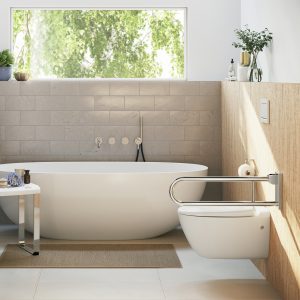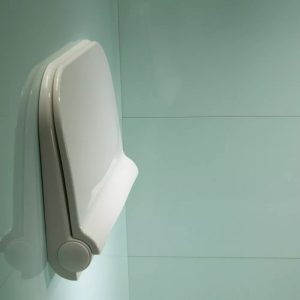Designing an Accessible Bathroom
Both stylish and functional bathrooms form an integral part of any modern home. However, for individuals with disabilities or limited mobility, these spaces can often present numerous challenges. Traditional bathroom designs may only sometimes cater to their needs, making what should be simple daily tasks more complex than they need to be. But the good news is, with advancements in design and a thoughtful approach to planning, it’s possible to create a bathroom space that is accessible and easy to use but also visually appealing and inviting.
In this comprehensive blog post, Showers to You delve into the critical considerations for crafting an accessible bathroom that marries functionality with aesthetics. We’ll explore making essential elements like showers, toilets, and basins more accessible without compromising style. We’ll discuss the importance of details like door widths, handle types, and fixture heights in creating a truly inclusive design. Additionally, we’ll touch upon the role of assistive devices like grab bars and shower seats in enhancing safety and comfort and how they can be seamlessly integrated into your bathroom’s overall design.
Install Grab Bars
Creating an accessible bathroom that meets the needs of individuals of all ages and physical conditions is crucial. Installing Grab Bars is one of the most effective and cost-friendly ways to achieve this. These simple yet essential fixtures can dramatically improve the safety and functionality of your bathroom space.
Firstly, grab bars provide a significant improvement in terms of stability and support. Navigating the bathroom can often be challenging for those with mobility issues or recovering from surgery. Grab Bars offer a secure handhold, making it easier for individuals to move around without fear of slipping or falling. They can be installed near the toilet, within the shower or bathtub, or anywhere else where additional support might be needed. This extra level of safety can offer peace of mind for the user and their loved ones.
Opt for a Walk-in Wetroom
Traditional bathtubs present challenges for individuals with mobility issues. Climbing over high sides and maintaining balance on potentially slippery surfaces can be difficult and risky. A more accessible, safer, and increasingly popular alternative is the walk-in Wetroom.
Walk-in Wetrooms are designed with convenience and accessibility in mind. They typically feature a curb less design, meaning there’s no need to step up or over anything to enter the shower. This makes them wheelchair-accessible, allowing easy and safe entry and exit.
Consider a Handheld Shower Head
One of the key benefits of a handheld showerhead is its versatility. It allows you to direct the water stream exactly where you need it. Whether rinsing off soap or shampoo or cleaning your shower, a handheld showerhead makes the task more accessible and efficient.
For individuals with mobility issues, this flexibility can be especially beneficial. A traditional showerhead requires users to move and adjust themselves to rinse off different areas. In contrast, a handheld showerhead can be transferred to target specific areas, reducing the need for physical adjustments that could lead to slips or falls.
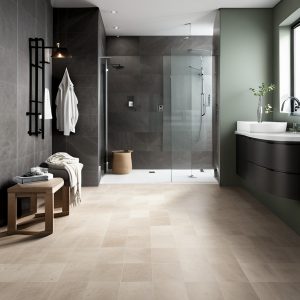 Choose Comfortable Flooring
Choose Comfortable Flooring
Tile flooring is popular in bathrooms for its aesthetics and water-resistance. However, it can be risky for individuals with limited mobility or disabilities. Tile surfaces, especially when wet, can become quite slippery, increasing the likelihood of falls.
A safer alternative is non-slip vinyl or laminate flooring. These materials offer enhanced traction underfoot, minimizing slip risks. They are excellent for creating a safer, more accessible bathroom environment.
Vinyl flooring, for instance, is not only slip-resistant but also water-resistant and durable. It’s available in various styles and colours, making finding an option that matches your bathroom décor easy. Moreover, vinyl is softer and warmer underfoot than tile, offering additional comfort.
Find a Comfort Height Toilet
These are an excellent addition to bathrooms designed for individuals with limited mobility or disabilities. The increased height makes it easier for people to sit down and stand up, especially those with knee or back issues, older people, or who use wheelchairs. By reducing the need to bend or squat significantly, Comfort Height Toilets help lessen the strain on the body, making the bathroom experience safer and more comfortable.
Add a Raised Toilet Seat
For individuals with limited mobility, everyday tasks such as using the toilet can become challenging. Standard toilets, typically lower than most chairs, can pose challenges for individuals when sitting or standing due to their height. This is where a raised toilet seat comes into play.
This toilet seat design is a simple yet effective solution to enhance bathroom accessibility. Increasing the height of the toilet reduces the distance a person has to move when sitting down or standing up. This can significantly ease the strain on the knees, hips, and back, making the process much more comfortable and manageable. Moreover, many raised toilet seats have additional features like armrests or handles, providing extra support and stability when sitting down or standing up.
Purchase a DOC M Pack
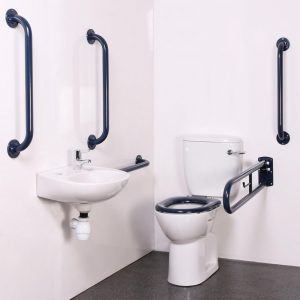
Doc M Packs stand for Approved Document M and are the ideal all-in-one set for an Accessible Bathroom design.
These packs typically include a range of fixtures such as grab rails, lever taps, raised-height toilets, and wheelchair-accessible basins, all designed to enhance the bathroom’s safety and ease of use. The primary benefit of DOC M Packs is that they provide a comprehensive solution for accessible bathrooms, eliminating the need to source individual items separately.
DOC M Packs enable individuals with disabilities or limited mobility to use the bathroom independently and safely. This can significantly enhance their quality of life, promoting dignity and self-sufficiency. Therefore, DOC M Packs are invaluable for designing bathrooms for less-abled individuals.
Design for Easy Accessibility
When designing an accessible bathroom, ensuring sufficient space for wheelchair users to move around comfortably and safely is crucial. Every detail counts, from the doors’ width to the room’s layout.
The placement of fixtures also plays a significant role in creating an accessible bathroom. For example, Vanity Units should be installed at a height easily reached from a seated position, with enough knee clearance underneath. Similarly, grab bars should be strategically placed near the toilet and shower area to provide support where needed.
Moreover, consider the placement of everyday items and toiletries. Shelves and storage areas should be at a height that is easily reachable from a wheelchair. This ensures that the user can independently access all necessary items without assistance.
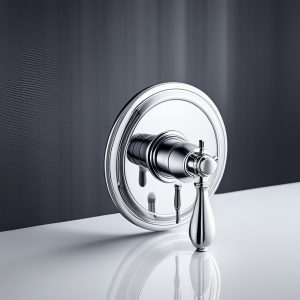 Consider Motion Sensor Faucets
Consider Motion Sensor Faucets
First and foremost, motion sensor faucets provide a touch-free operation. They are equipped with infrared sensor technology that detects the presence of hands under the Tap and automatically turns the water on or off. No twisting or turning handles needed, making them perfect for people with limited hand or arm mobility.
The touchless feature is beneficial for sensory-sensitive individuals, avoiding contact with extreme temperature metal surfaces.
Install Lever Handles
Traditional knobs, whether on doors or Shower Valves, can indeed pose a challenge for people with disabilities or limited mobility. These tools often require a firm grip and twisting motion. This can be challenging for those with hand strength or dexterity conditions.
On the other hand, Lever handles are a much more accessible option. They operate with a simple push-down mechanism, making them easier for people with various levels of strength and mobility. You can operate them with your hand, elbow, or side of the arm, showcasing their high versatility.
Add a Shower Seat
Shower seats are vital in designing accessible bathrooms for individuals with limited mobility or disabilities. They offer a place to sit while showering, reducing the risk of slips and falls and making the process considerably safer and more comfortable. A Shower Seat provides support for those struggling to stand for extended periods.
Typically, they’re crafted from durable, water-resistant plastic or stainless steel for long-lasting use. Some models also feature safety elements like non-slip surfaces and armrests for added stability.
To Conclude
Creating an accessible bathroom is an essential but often overlooked aspect of home design. With thoughtful planning and the right supplies, it is possible to create a functional space accessible to everyone. Showers to You provides diverse, top-notch supplies for crafting safe, accessible bathroom and shower spaces. No matter if you’re a homeowner, plumber, or bathroom installer, we supply everything needed for crafting universally welcoming, safe spaces. Contact one of our experts today via email (info@showerstoyou.co.uk), telephone (01472 242159) or online contact form.
